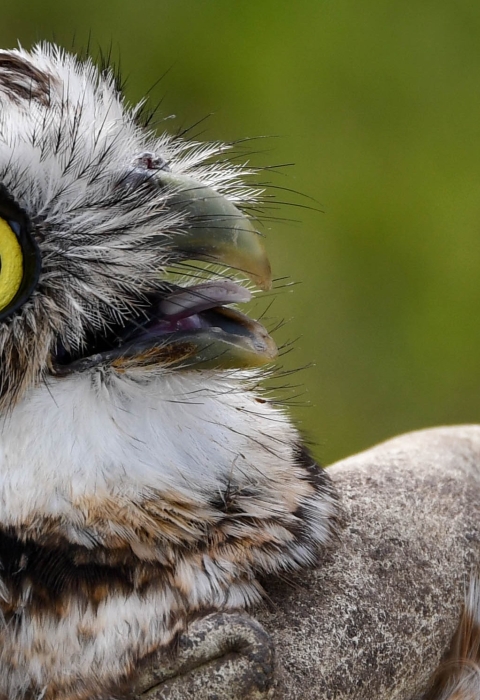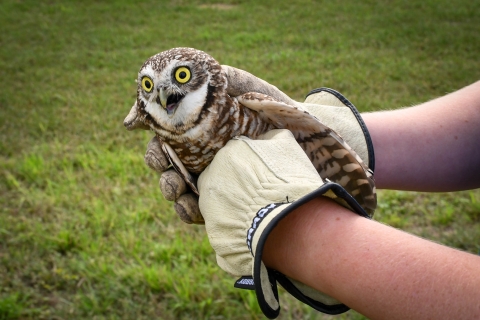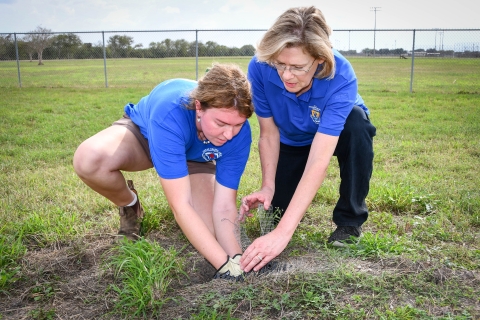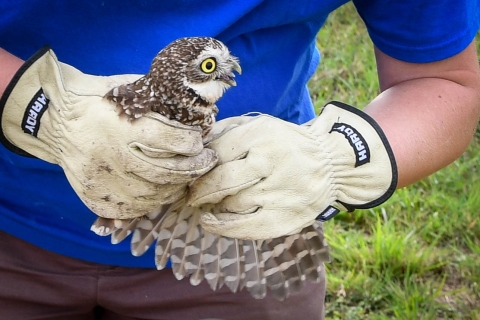Plenty of snowbirds visit South Texas this time of year to enjoy the mild weather and sunshine, but not every winged species can be spotted by looking up at the sky. During the daytime, ground-dwelling Western burrowing owls can be found near their underground homes to stay safe from predators.
“We like to call them our ‘little Winter Texans,’” said Mary Kay Skoruppa, a wildlife biologist with the Texas Coastal Ecological Services Field Office. “We have winter Texans of the human variety that are here only in the winter, and it’s the same with burrowing owls in South Texas. They are unusual in that they don’t like trees – they like open grasslands – and they rely on a burrow to survive.”
Western burrowing owls mostly go undetected by people during the winter, in part because their brown and buffy-white spotted feathers are easily camouflaged by the vegetation surrounding their burrows, and also because the tiny owls usually sit nearly motionless during the daytime. Like most other owls, the daytime is when they roost and are least active.
But in late October, the Texas Sealife Center in Corpus Christi received not one, but two calls from citizens who spotted the reclusive owls in places where they shouldn’t have been. One was found in a private homeowner’s yard in Robstown, Texas, with an injured wing; and the other was found on the ground near a crowd of people in downtown Corpus Christi, likely becoming weary during its winter migration.
As a non-profit organization dedicated to the rescue, rehabilitation and release of coastal and aquatic wildlife, the Texas Sealife Center was more than equipped to patch the owls up and get them ready to return to the wild. But because the owls prefer very specific habitat for their winter roost sites, the Center called on Skoruppa to assist with finding the right place to release them.
“This is only the second time that we’ve had burrowing owls at the Texas Sealife Center, so it’s a pretty uncommon encounter,” said Amanda Terry, Director of Rehabilitation at the Center. “I wanted to coordinate with Mary Kay because they do have specialized habitat requirements and we wanted to figure out a good place to send them on their way.”
Western burrowing owls typically use the abandoned burrows of prairie dogs, ground squirrels, and other burrowing animals as summer nesting and winter roost sites throughout their range from Canada down to southern Central America.
But the portion of the population that prefers to roost during the winter in South Texas don’t have that option.
“This area that we’re in used to have a lot of native short grass prairie, and that’s why Western burrowing owls are still coming to these areas, but unfortunately instead of using mammal burrows in native grasslands, they are using road culverts in plowed fields,” Skoruppa said. “That presents danger from vehicles, and they also may not be getting enough to eat in a plowed field like they would in a native grassland.”
In 2006, Skoruppa teamed up with staff from the United States Geological Survey to find out more about the winter distribution, abundance and ecology of wintering burrowing owls in Texas. One of their research questions: “What type of burrow do they select?”
“We put out different diameters, different configurations, and different number of openings, and what we found was that their favorite is 6-inch burrows in an east-west orientation to keep the cold north winds from blowing in,” Skoruppa said.
With these preferences in mind, Skoruppa and the team later collaborated with Nueces County Inland Parks to create a set of artificial burrows that could host the species on public land. At Robstown County Park near Robstown, Texas, a large fenced-in area now houses four artificial burrows made out of partially submerged drainage pipes.
While they have mostly been dormant since construction, this December the burrows came in handy when the Texas Sealife Center needed a place to release the rehabilitated Western burrowing owls.
During the release, the team had to keep some important considerations in mind before letting the owls go. In addition to making sure the burrows were safe for the birds and free from snakes and fire ants, the team also had to scan the sky to make sure there weren’t any hawks around hoping to get an easy snack.
After ensuring the burrows were fit for the release, the team gently placed the owls into the drainage pipes and closed them shut with chicken wire to give the birds an opportunity to get used to their new surroundings. After a few minutes, the volunteers gently removed the chicken wire, officially ending their brief stint in rehab.
When the owls stayed inside the burrows instead of flying away, the team smiled and breathed a sigh of relief. For now, the owls had seemingly approved of their new homes.
Terry said though she has released countless rehabilitated wildlife, the feeling of seeing an animal back in its native habitat is always a joy.
“That’s why we do it and why we work through holidays – it never gets old,” Terry said.
While the release of the rehabilitated Western burrowing owls is a spot of good news, throughout the species’ range the owls are in decline. In addition to being listed as federally threatened in Mexico and endangered in Canada, in the United States it is considered a National Bird of Conservation Concern by the U.S. Fish and Wildlife Service and a species of greatest conservation need by the Texas Parks and Wildlife Department.
Some important factors identified in the decline of the western burrowing owl are habitat loss resulting from conversion of grasslands to intensive cultivation of row crops and a decline in available burrows due to widespread eradication of prairie dogs and large ground squirrels.
While Nueces County Parks continues to maintain a few artificial burrows for Western burrowing owls, Skoruppa said there remains a need for more burrowing owl habitat, especially in the five-county area surrounding Corpus Christi (Jim Wells, Kleberg, Nueces, Refugio, and San Patricio).
“They have to have a burrow, and there’s not that many of them in South Texas,” Skoruppa said. “Artificial burrows are a great way to try to attract them if you have the habitat. It can be in a mowed or grazed open field or even in a place like an airport or cemetery.”
For more information on artificial burrows, and how to create one for a Western burrowing owl, see the report titled “Winter Ecology of the Western Burrowing Owl” here.









